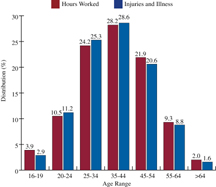|

SAFETY SOLUTIONS: The Aging Workforce
Maintaining the Safety and Health of a Diverse Workforce
As workers born between 1946 and 1964, the
large ‘baby boomer’ generation, age so too does
our workforce while the labor pool shrinks.
Currently, workplace injury rates for older workers are the
lowest of any age group, but their fatality rate is the highest.
To accommodate the aging workforce and to work to
reduce fatality rates, businesses should design a safe
workplace for this aging, but valuable, workforce or be
faced with a negative economic impact.
Businesses must act now to accommodate and provide
a safer work environment for the aging worker, a valuable
and experienced group, or their bottom line will be
impacted negatively. There are easy and economical ways
to do this that, in the long run, will save time, increase
output and contribute positively to the business.
The U.S. Department of Labor’s (DOL) workplace statistics
for 2004 show that those 64 and older had the lowest
number of workplace injuries, but the fatality rate for
those 55 and older rose by 10 percent. In 2003, workers
65 and older continued to record the highest fatality rate
of any other age group, more than three times the rate of
fatalities for those aged 25-34, according to the DOL.
Most of these fatalities were transportation-related, from
falls, from being struck by an object and from homicides.
As baby boomers begin to retire over the next few
years, the DOL notes the workforce will shrink as those
born from 1965 to 1985, a time with a declining
birthrate, enter the workforce. According to American
Demographics magazine, currently there are 76.9 million
baby boomers in the U.S. The majority of boomers live in
California, Florida, Illinois, Michigan, New Jersey, New
York, Ohio, Pennsylvania and Texas.
As the percentage of the workforce aged 55 and over
increases, injury rates for the whole work population decreases
while productivity increases An estimated 3.9 million occupational
injuries and illnesses were treated in hospital emergency
departments among all industry and occupation groups
for workers aged 15 and older. The highest numbers of these
injuries and illnesses occurred among workers aged 25-44.
Existing data suggests there is no age-related safety
performance issue between the 25-54 year age group
and that of the over 55 years age group, according to
2001-02 statistics. Older workers are not more prone to
injury and illness than other workers. Older workers have
fewer avoidable absences, a lower turnover rate, and
fewer work-related accidents.
To increase workplace safety,
employer fixes – environmental
changes – can cost next to nothing,
yet the return on investment is very
high
Management needs to be prepared
to accommodate the number
of changes older workers may face
such as physical, sensory and perhaps
some mental impediments.
As we age we get shorter and heavier,
our muscle strength decreases
and by age 65, the mean maximum
aerobic power – the level at
which oxygen uptake levels off – is
about 70 percent of what it was at
age 25. Hearing and vision is also
diminished as one ages.
Most experts agree that despite
the aging process and its risks,
older workers are not likely to take
it easy on the job. Even though
older workers face additional
obstacles to performing their job,
they bring experience and knowledge
and an excellent work ethic to
the job, making them a valuable
part of the work force. Equipment,
facilities and work processes can
be improved to account for the limitations
of the aging workforce and
to take advantage of their experience
and capabilities.
Knowing that there is no onesize-
fits-all solution, the following
are suggestions that can increase
workplace safety for an aging workforce:
Improve illumination, add color
contrast
Eliminate heavy lifts, elevated
work from ladders and long
reaches
Design work floors and platforms
with smooth and solid decking
while still allowing some cushioning
Reduce static standing time
Remove clutter from control panels
and computer screens and
use large video displays
Reduce noise levels
Install chain actuators for valve
hand wheels, damper levers or
other similar control devices –
this brings the control manipulation
to ground level – helps
reduce falls
Install skid resistant material for
flooring and especially for stair
treads – helps reduce falls
Install shallow-angle stairways in
place of ladders when space permits
and where any daily elevated
access is needed to complete
a task – helps reduce falls
Utilize hands free volume
adjustable telephone equipment
Increase task rotation which will
reduce the strain of repetitive
motion
Lower sound system pitches,
such as on alarm systems, as
they tend to be easier to hear
Lengthen time requirements
between steps in a task
Increase the time allowed for
making decisions
Consider necessary reaction time
when assigning older workers to
tasks
Provide opportunities for practice
and time to develop task
familiarity
Implementing these changes
would not only help older workers,
but would benefit all workers.
Wishing you all a safe and happy
New Year and a prosperous 2006!
For more information, click on the Author Biography link at the top of this page.
|